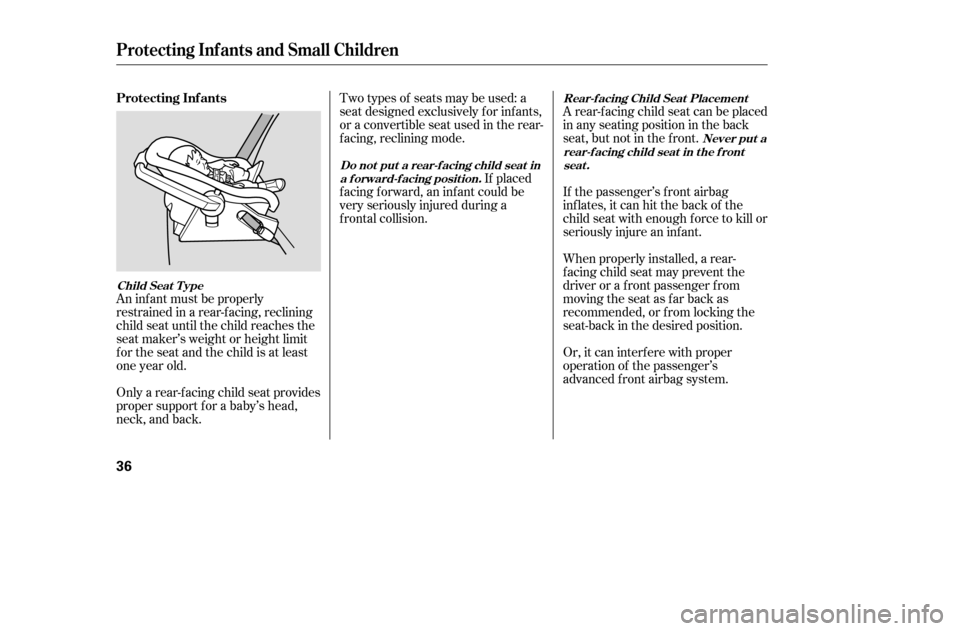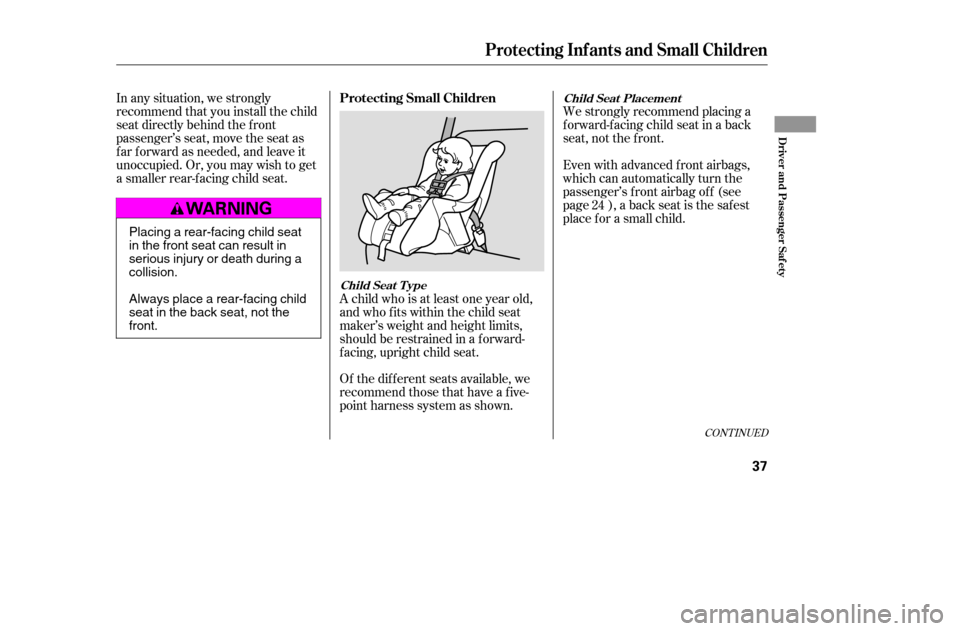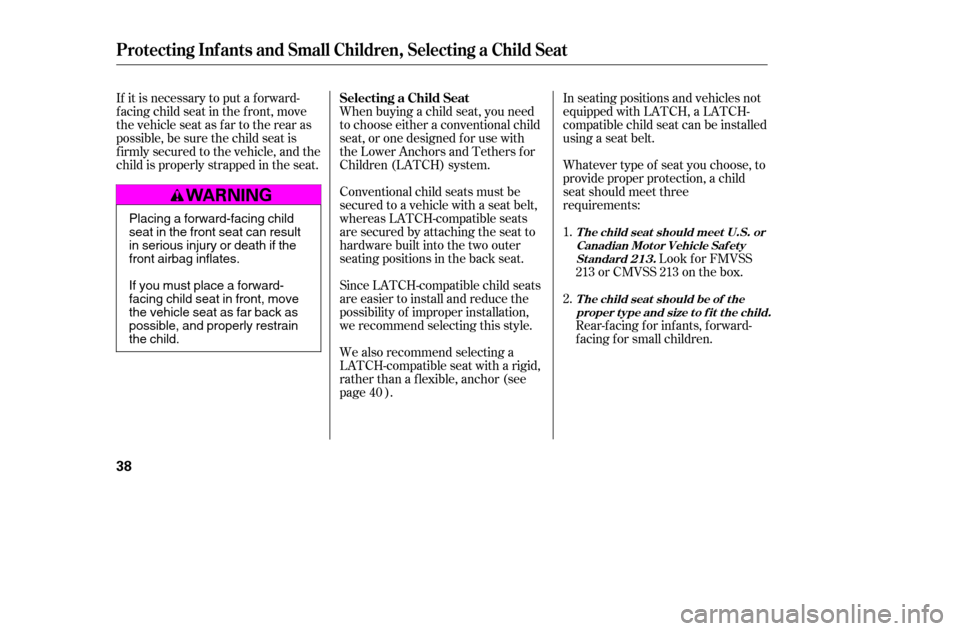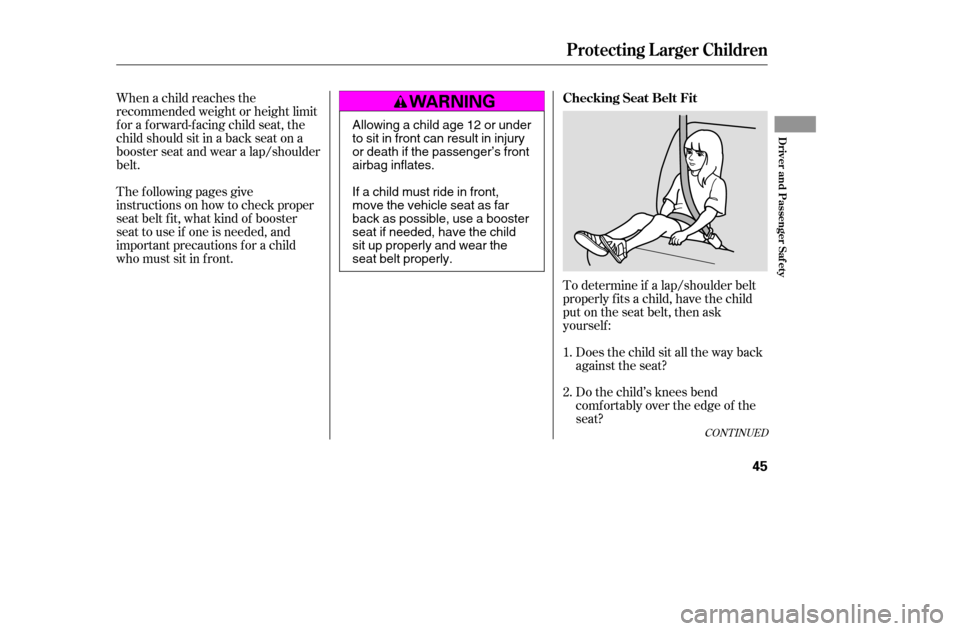Page 33 of 289

An inf ant must be properly
restrained in a rear-f acing, reclining
child seat until the child reaches the
seat maker’s weight or height limit
for the seat and the child is at least
one year old.
Only a rear-f acing child seat provides
proper support f or a baby’s head,
neck, and back.Two types of seats may be used: a
seat designed exclusively f or inf ants,
or a convertible seat used in the rear-
f acing, reclining mode.
If placed
f acing f orward, an inf ant could be
very seriously injured during a
f rontal collision. A rear-f acing child seat can be placed
in any seating position in the back
seat, but not in the f ront.
If the passenger’s f ront airbag
inflates, it can hit the back of the
child seat with enough f orce to kill or
seriously injure an inf ant.
When properly installed, a rear-
f acing child seat may prevent the
driver or a f ront passenger f rom
moving the seat as far back as
recommended, or f rom locking the
seat-back in the desired position.
Or, it can interf ere with proper
operation of the passenger’s
advanced front airbag system.
Protecting Inf ants
Child Seat T ype
Do not put a rear-f acing child seat in
a f orward-f acing position. Rear-f acing Child Seat Placement
Never put a
rear-f acing child seat in t he f ront seat .
Protecting Inf ants and Small Children
36
�����—�����—�����y�
���������
�
�y���
�(���%�������y���������y
Page 34 of 289

A child who is at least one year old,
and who fits within the child seat
maker’s weight and height limits,
should be restrained in a f orward-
f acing, upright child seat.
Of the different seats available, we
recommend those that have a f ive-
point harness system as shown.
In any situation, we strongly
recommend that you install the child
seat directly behind the f ront
passenger’s seat, move the seat as
f ar f orward as needed, and leave it
unoccupied. Or, you may wish to get
a smaller rear-f acing child seat.
We strongly recommend placing a
forward-facing child seat in a back
seat, not the f ront.
Even with advanced front airbags,
which can automatically turn the
passenger’s f ront airbag of f (see
page ), a back seat is the saf est
place f or a small child.
24
CONT INUED
Protecting Small Children
Child Seat T ype Child Seat Placement
Protecting Inf ants and Small Children
Driver and Passenger Saf ety
37
Placing a rear-facing child seat
in the front seat can result in
serious injury or death during acollision.
Always place a rear-facing child
seat in the back seat, not thefront.
�����—�����—�����y�
�������������y���
�(���%�������y���������y
Page 35 of 289

Conventional child seats must be
secured to a vehicle with a seat belt,
whereas LATCH-compatible seats
are secured by attaching the seat to
hardware built into the two outer
seating positions in the back seat.
Since LATCH-compatible child seats
are easier to install and reduce the
possibility of improper installation,
we recommend selecting this style.
We also recommend selecting a
LATCH-compatible seat with a rigid,
rather than a f lexible, anchor (see
page ).
If it is necessary to put a f orward-
f acing child seat in the f ront, move
the vehicle seat as far to the rear as
possible, be sure the child seat is
f irmly secured to the vehicle, and the
child is properly strapped in the seat.
When buying a child seat, you need
to choose either a conventional child
seat, or one designed f or use with
the Lower Anchors and Tethers f or
Children (LATCH) system.In seating positions and vehicles not
equipped with LATCH, a LATCH-
compatible child seat can be installed
using a seat belt.
Whatever type of seat you choose, to
provide proper protection, a child
seat should meet three
requirements:
Look f or FMVSS
213 or CMVSS 213 on the box.
Rear-facing for infants, forward-
f acing f or small children.
1. 2.
40
Selecting a Child Seat
Protecting Inf ants and Small Children, Selecting a Child Seat
T he child seat should meet U.S. or
Canadian Mot or Vehicle Saf et ySt andard 213.
T he child seat should be of theproper t ype and size t o f it t he child.
38
Placing a forward-facing child
seat in the front seat can result
in serious injury or death if the
front airbag inflates.
Ifyoumustplaceaforward-
facing child seat in front, move
the vehicle seat as far back as
possible, and properly restrain
the child.
�����—�����—�����y�
�������������y���
�(���%�������y�������
�y
Page 42 of 289

When a child reaches the
recommended weight or height limit
for a forward-facing child seat, the
child should sit in a back seat on a
booster seat and wear a lap/shoulder
belt.To determine if a lap/shoulder belt
properly f its a child, have the child
put on the seat belt, then ask
yourself :Does the child sit all the way back
against the seat?
Do the child’s knees bend
comf ortably over the edge of the
seat?
The f ollowing pages give
instructions on how to check proper
seat belt f it, what kind of booster
seat to use if one is needed, and
important precautions f or a child
who must sit in f ront.
1. 2.
CONT INUED
Protecting L arger Children
Checking Seat Belt Fit
Driver and Passenger Saf ety
45
Allowing a child age 12 or under
to sit in front can result in injury
or death if the passenger’s front
airbag inflates.
If a child must ride in front,
move the vehicle seat as far
back as possible, use a booster
seat if needed, have the child
sit up properly and wear the
seat belt properly.
�����—�����—�����y�
������
����
�y���
�(���%�������y���������y
Page 44 of 289

If you decide that a child can saf ely
ride up f ront, be sure to:Caref ully read the owner’s manual,
and make sure you understand all
seat belt instructions and all saf ety
inf ormation.
Move the vehicle seat to the rear-
most position.
Have the child sit up straight, back
against the seat, and feet on or
near the f loor.
Check that the child’s seat belt is
properly and securely positioned.
Supervise the child. Even mature
children sometimes need to be
reminded to f asten the seat belts
or sit properly.
To saf ely ride in f ront, a child must
be able to f ollow the rules, including
sitting properly, and wearing the seat
belt properly throughout a ride.
Of course, children vary widely. And
while age may be one indicator of
when a child can saf ely ride in f ront,
there are other important f actors you
should consider.
The National Highway Traffic Safety
Administration and Transport
Canada recommend that all children
age 12 and under be properly
restrained in a back seat.
If the passenger’s f ront airbag
inf lates in a moderate to severe
f rontal collision, the airbag can cause
serious injuries to a child who is
unrestrained, improperly restrained,
sitting too close to the airbag, or out
of position.
A side airbag also poses risks. If any
part of a larger child’s body is in the
path of a deploying side airbag, the
child could receive possibly serious
injuries. Physically, a child must be large
enough f or the lap/shoulder belt to
properly f it (see pages and ). If
the seat belt does not f it properly,
with or without the child sitting on a
booster seat, the child should not sit
in f ront.
14 45
Protecting L arger Children
Maturity
Physical Size
When Can a L arger Child Sit in
Front
Driver and Passenger Saf ety
47
�����—�����—�����y�
�������������y���
�(���%�������y���������y
Page 51 of 289
�Î�Î
�Î
The U.S. instrument panel is shown. Dif f erences f or the Canadian models are noted in the text.
Instrument Panel
Inst rument s and Cont rols
55
LOW FUEL INDICATORMAINTENANCE REQUIRED
INDICATOR
HIGH BEAM INDICATOR
CRUISE MAIN INDICATOR ANTI-LOCK BRAKE SYSTEM
INDICATOR
LOW OIL PRESSURE
INDICATOR
CHARGING SYSTEM
INDICATOR
SECURITY SYSTEM INDICATORSUPPLEMENTAL
RESTRAINT SYSTEM
INDICATOR
TCS ACTIVATION INDICATOR
CRUISE CONTROL INDICATOR
DOOR AND TRUNK
OPEN MONITOR
LIGHTS ON INDICATOR
PARKING BRAKE AND BRAKE
SYSTEM INDICATOR TRACTION CONTROL SYSTEM (TCS)
INDICATOR
MALFUNCTION INDICATOR LAMP IMMOBILIZER SYSTEM INDICATOR
SEAT BELT REMINDER INDICATOR (P.58)
(P.61)
(P.58) (P.59)
(P.61) (P.59)
(P.57)
(P.60, 151) (P.56)
(P.60)
(P.57, 262)
(P.261) (P.56, 260)
(P.56, 260)
(P.61)(P.61)
(P.58)
SIDE AIRBAG OFF
INDICATOR(P.57)
(P.60)
�����—�����—�����y�
�������������y���
�(���%�������y���������y
Page 53 of 289

This indicator has two f unctions:This indicator comes on brief ly when
you turn the ignition switch to ON
(II). If it comes on at any other time,
it indicates a potential problem with
your f ront airbags. This indicator will
also alert you to a potential problem
with your side airbags, passenger’s
side airbag automatic cutoff system,
side curtain airbags, automatic seat
belt tensioners, driver’s seat position
sensor, or the f ront passenger’s
weight sensors. For more
inf ormation, see page .This indicator comes on when you
turn the ignition switch to ON (II). If
it comes on at any other time, it
indicates that the passenger’s side
airbag has automatically shut off.
For more inf ormation, see page .
Itcomesonwhenyouturnthe
ignition switch to ON (II). It is a
reminder to check the parking
brake. A beeper sounds if you try
to drive with the parking brake not
f ully released. Driving with the
parking brake not f ully released
can damage the brakes and tires.
If it remains lit af ter you f ully
release the parking brake while
the engine is running, or if it
comes on while driving, there
could be a problem with the brake
system. For more inf ormation, see
page .
1. 2.
28
262 27
Instrument Panel Indicators
Parking Brake and Brake System
Indicator
Supplemental Restraint
System Indicator
Side Airbag Of f Indicator
Inst rument s and Cont rols
57
U.S. Canada U.S. Canada
�����—�����—�����y�
�������������y���
�(���%�������y���������y
Page 62 of 289
�Î
�Î
To use the horn, press the pad around the ‘‘H’’ logo.
Controls Near the Steering Wheel
66
EX-V6 model without navigation system is shown.CRUISE CONTROLS
TILT/TELESCOPIC ADJUSTMENT
REMOTE AUDIO
CONTROLS
MOONROOF
SWITCH
TRACTION CONTROL
SYSTEM ON/OFF SWITCH
HEADLIGHTS/
TURN SIGNALS
HORN INSTRUMENT PANEL
BRIGHTNESS WINDSHIELD
WIPERS/WASHERS
REAR WINDOW
DEFOGGER
AUDIO SYSTEM
HAZARD WARNING
BUTTON
PASSENGER
AIRBAG OFF
INDICATOR
(P.68) (P.70)
(P.67)
(P.28)
(P.70)
(P.116)
(P.71)
(P.152)
(P.72)
(P.188)
(P.92)
(P.148)
�����—�����—�����y�
�������������y���
�(���%�������y���������y